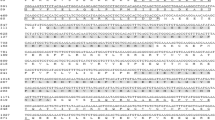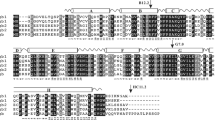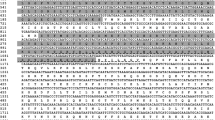Abstract
The heme oxygenase gene plays a role in many biological processes and is an important protective factor in hypoxic stress. Research on the HO gene of fishes has attracted increasing attention, but there is yet little information about the cobia (Rachycentron canadum) heme oxygenase gene. In this study, the full-length cDNA of the cobia heme oxygenase gene (heme oxygenase, HO) was cloned using rapid amplification of cDNA ends technology. The full-length cDNA was 1639 bp and the open reading frame (ORF) was 840 bp encoding 279 amino acids, with 5′-UTR 518 bp and 3′-UTR 281 bp. The results of real-time quantitative PCR showed that cobia HO was expressed in all the tissues tested, with the highest expression in gills. The mRNA expression of gill HO increased after hypoxia stress. There was no significant change in the expression of HO mRNA in the liver after hypoxia stress. The amino acid sequences of HO in diverse fish and mammals have varying levels of homology. Our results indicate that the biological functions of HO may be similar in fish and mammals, suggesting an important protective factor in response to hypoxic stress.







Similar content being viewed by others
References
Abdalla M, Mathahs M, Ahmad I (2012) Protective role of heme oxygenase-1 in liver. Biologia 67(4). https://doi.org/10.2478/s11756-012-0058-1
Amenyogbe E, Chen G, Wang Z (2019) Identification, characterization, and expressions profile analysis of growth hormone receptors (GHR1 and GHR2) in hybrid grouper (Epinephelus fuscoguttatus ♀ × Epinephelus polyphekadion ♂). Genomics. 112:1–9. https://doi.org/10.1016/j.ygeno.2019.05.012
Basu M, Paichha M, Lenka SS, Chakrabarty R, Samanta M (2016) Hypoxic stress: impact on the modulation of TLR2, TLR4, NOD1 and NOD2 receptor and their downstream signalling genes expression in catla (Catla catla). Mol Biol Rep 43:1–9
Bowden T J (2008) Modulation of the immune system of fish by their environment. Fish & Shellfish Immunology, 25(4): 0–383, 373
Chen S (2016) Study on physiological tissue and related gene expression changes in the liver and organs of the ovoid liver and organs under acute and chronic hypoxia stress. Shanghai Ocean University 02:70–79
Chen S, Wang P, District and Jun, et al (2016) The effects of acute and chronic hypoxia stress on the damage and antioxidant effects of Trachinotus ovatus liver tissue in young fish. J Zool 51(6):1049–1058
Chen Y, Fan Z, Yang Y, Gu C (2019) Iron metabolism and its contribution to cancer (review). Int J Oncol. https://doi.org/10.3892/ijo.2019.4720
Chixiao J, Xu X (2009) Advances in the study of hemoglobin oxygenase-1. China Medical Guide 27:11–12
Elgrabli D, Dachraoui W, Hde M, Ménard-Moyon C, Bégin D, Bégin-Colin S et al (2017) Intracellular degradation of functionalized carbon nanotube/iron oxide hybrids is modulated by iron via Nrf2 pathway. Sci Rep 7(1). https://doi.org/10.1038/srep40997
Faek-San, Shu X (2000) heat shock protein and apoptosis. J Hubei Inst Sci Technol (medical edition), (01): 72–73
Foulds CE, Treviño LS, York B, Walker CL (2017) Endocrine-disrupting chemicals and fatty liver disease. Nat. Rev Endocrinol 13(8):445–457
Fraser ST, Midwinter RG, Berger BS, Stocker R (2011) Heme oxygenase-1: a critical link between Iron metabolism, erythropoiesis, and development. Advances in Hematology 2011:1–6. https://doi.org/10.1155/2011/473709
Giorgi C, Marchi S, Simoes ICM, Ren Z, Morciano G, Perrone M et al (2018) Mitochondria and reactive oxygen species in aging and age-related diseases. Mitochondria and Longevity 340:209–344. https://doi.org/10.1016/bs.ircmb.2018.05.006
Guo H (2009) Artificial transcription factor construction of special upward HO-1 gene expression. Third Military Medical University, (06): 43–66
Heath AG (1988) Anaerobic and aerobic energy metabolism in brain and liver tissue from rainbow trout (Salmo gairdneri) and bullhead catfish (Ictalurus nebulosus). J Exp Zool 248(2):140–146
Koppang EO, Fischer U, Moore L et al (2010) Salmonid T cells assemble in the thymus, spleen and in novel interbranchial lymphoid tissue. J Anat 217(6):728–739
Kurz T, Eaton JW, Brunk UT (2011) The role of lysosomes in iron metabolism and recycling. Int J Biochem Cell Biol 43(12):1686–1697. https://doi.org/10.1016/j.biocel.2011.08.016
Lai KP, Tam N, Wang SY, Lin X, Chan TF, Au DWT, Wu RSS, Kong RYC (2020) Hypoxia causes sex-specific hepatic toxicity at the transcriptome level in marine medaka (Oryzias melastigma). Aquat Toxicol 105520:105520. https://doi.org/10.1016/j.aquatox.2020.105520
Leffler CW, Parfenova H, Jaggar JH (2011) Carbon monoxide as an endogenous vascular modulator. Am J Phys Heart Circ Phys 301(1):H1–H11. https://doi.org/10.1152/ajpheart.00230.2011
Li Y (2015) Low oxygen protection effect of zebrafish hemoglobin and oxygenase 1 and genetically modified fish research. Central China Normal University, (01): 50–57
Li Y, Xu G, Xiao J et al (2017) Study on the protective effect of hemoglobin oxygenase 1 in low oxygen stress in zebrafish. Aquat Biol 1:43–49
Li L, Zhao Q, He J et al (2018) TIGAR gene over-expresses its effect on low oxygen compound oxygen damage to hippocampus neurons in rats. Ziru J Med 33(03):230–233
Lin C-H, Lo W-C, Hsiao M, Tseng C-J (2003) Interaction of carbon monoxide and adenosine in the nucleus tractus solitarii of rats. Hypertension 42(3):380–385. https://doi.org/10.1161/01.hyp.0000088561.17252.42
Liu F (2014) Cloning, expression and function analysis of two hemoglobin oxygenates genes in Trachidermus fasciatus. Shandong University 10:80–88
Mali F (2009) Study on the change and effect of hemoglobin oxygenase-1/carbon monoxide system (HO-1/CO) in oxygen-deprived ischemic brain in newborn mice. Tianjin Medical University 27:65–71
Medina MV, Sapochnik D, Garcia Sola ME, Coso OA (2019) Regulation of the expression of heme oxygenase-1. Signal Transduction, Gene Promoter Activation and Beyond. Antioxid Redox Signal. https://doi.org/10.1089/ars.2019.7991
Mo J, Yu X (1998) Advances in the study of hemoglobin oxygenase. Biotechnol Bull 02:19–24
Muñoz-Sánchez J, Chánez-Cárdenas ME (2014) A review on hemeoxygenase-2: focus on cellular protection and oxygen response. Oxidative Med Cell Longev 2014:1–16. https://doi.org/10.1155/2014/604981
Nikinmaa M, Rees BB (2005) Oxygen-dependent gene expression in fishes. Am J Physiol Regul Integr Comp Physiol 288:R1079–R1090 (Review)
Padmavathy P, Ramanathan N, Francis T (2003) Glucose, lactate and pyruvate metabolism in Labeo rohita with reference to ambient oxygen. Asian Fish. Sci. 16:51–58
Panchenko MV, Farber HW, Korn JH (2000) Induction of heme oxygenase-1 by hypoxia and free radicals in human dermal fibroblasts. Am J Physiol Cell Physiol 278:C92–C101
Rashid I, Baisvar VS, Singh M, Kumar R, Srivastava P, Kushwaha B, Pathak AK (2020) Isolation and characterization of hypoxia inducible heme oxygenase 1 (HMOX1) gene in Labeo rohita. Genomics 112:2327–2333. https://doi.org/10.1016/j.ygeno.2020.01.004
Singh SP, Sharma J, Ahmad T, Chakrabarti R (2016) Oxygen stress: impact on innate immune system, antioxidant defence system and expression of HIF-1α and ATPase 6 genes in Catla catla, fish Physiol. Biochem. 42:673–688
Su-in (2012) Cloning and expression of the gene of hemoglobin-oxygenase-1 (HO-1). Huazhong Agricultural University, (02): 60–65
Sun W, Zhao X, Wang G et al (2003) Changes in biological function of small intestine epithelial cell brush-like dipeptide transport vector after hypoxic reoxygenation damage and regulation of growth hormone. PLA Med J 28(11):1025–1027
Tao W, Wang L, Hou S et al (2014) Study on the expression characteristics and functions of zebrafish HO1 gene. Aquat Biol 38(02):209–215
Tvrdá E, Massanyi P, Lukáč N (2017) Physiological and pathological roles of free radicals in male reproduction, Spermatozoa - Facts and Perspectives, Rosaria Meccariello and Rosanna Chianese, IntechOpen, DOI: https://doi.org/10.5772/intechopen.70793. Available from: https://www.intechopen.com/books/spermatozoa-facts-and-perspectives/physiological-and-pathological-roles-of-free-radicals-in-male-reproduction
Tzaneva V, Perry SF (2014) Heme oxygenase-1 (HO-1) mediated respiratory responses to hypoxia in the goldfish, Carassius auratus. Respir Physiol Neurobiol 199:1–8
Varghese T, Pal AK, Mishal P, Sahu NP, Dasgupta S (2017) Physiological and molecular responses of a bottom dwelling carp, Cirrhinus mrigala to short-term environmental hypoxia. Turk J Fish Aquac Sci 18:483–490
Wang D (2010) Screening of the low oxygen reaction gene of mackerel and the characteristic analysis of hemoglobin oxygenase-1 gene. Institute of Aquatic Biology. Institute of Aquatic Biology. Chinese Academy of Sciences, Beijing, pp 50–59
Wang X (2013) Expression analysis of microtubation protein-related genes and heat shock protein 70 under low oxygen stress. Huazhong Agricultural University, (02): 69–75
Wang Q, Yan T, Zhou F (2012) Advances in the study of the causes of low oxygen and their effects in near shore and estuary. Mar Environ Sci 5:153–156
Wang Z, Liang H, Du X et al (2013) Cloning and expression analysis of the HSP60 gene of Ma’s beaded mother behestafever shock protein HSP60 gene. J Guangdong Ocean Univ 33(06):14–23
Wenjun C, Zhenxuan X, Xuehong Z et al (2004) Advances in human hemoglobin oxygenase-1 research. Life Sci 14(4):204–207
Xiao W (2015) The hypoxia signaling pathway and hypoxic adaptation in fishes. Sci China Life Sci 58(2):148–155
Xiong X, Huang G, Peng Y et al (2016) Effects of low oxygen stress on the growth, energy metabolism and oxidative stress of young fish. Aquatic J 40(1):73–82
Xu Z (2018) Study on the differential proteomics and heat shock-induced four-fold sports species of grass fish under low oxygen stress. Shanghai Ocean University, (05): 55–60
Yan N, Kong X, Jiang H (2012) Advances in the function and expression regulation of hemoglobin and oxygenase-1 in fish. Biol Teach 36(12):2–3
Yang X, Huang W, Wei Z et al (2006) Signaling pathways inducing HO-1 gene expression. J Clin Pathol 26(3):238–242
Yang M, Fan J, Du J, Peng X (2020) Small-molecule fluorescent probes for imaging gaseous signaling molecules: current progress and future implication. Chem Sci 11:5127–5141. https://doi.org/10.1039/d0sc01482f
Zhang Z, Zhou W, Chen G et al (2013) Effect of soybean meal content in feed on carbon and nitrogen stable isotope fractionation of military Cao fish larvae. Guangdong Ocean Univ J 33(06):30–36
Zhao Y (2018) Study on the regulation of low oxygen stress transcriptome and its main difference gene expression. Qinghai University 09:63–84
Zhu CD, Wang ZH, Yan B (2013) Strategies for hypoxia adaptation in fish species: a review. J Comp Physiol B 183(8):1005–1013
Acknowledgments
Our sincere acknowledgement goes to the funders of this study.
Data availability statement
Upon reasonable demand, the data supporting the results of this study are obtainable from the corresponding author.
Funding
This work was supported by grants from the China Agriculture Research System (CARS-47), Southern Marine Science and Engineering Guangdong Laboratory (Zhanjiang) (ZJW-2019-06)], and Guangdong Ocean University Undergraduate Innovation and Entrepreneurship Training Program (CXXL2018131).
Author information
Authors and Affiliations
Contributions
All authors contributed equally to this work.
Corresponding author
Ethics declarations
Conflict of interest
The authors confirm that there are no conflicts of interest.
Ethics statement
This study was conducted in compliance with the Guangdong Ocean University Research Council’s Guide for the Care and Use of Laboratory Animals. Fish were anesthetized with ethyl-3-aminobenzoate methanesulfonate (MS-222; Sigma, USA) for tissue collection.
Additional information
Publisher’s note
Springer Nature remains neutral with regard to jurisdictional claims in published maps and institutional affiliations.
Electronic supplementary material
Supplementary Table 1
(DOCX 13 kb)
Supplementary Figure 2
(PNG 4948 kb)
Rights and permissions
About this article
Cite this article
Xie, Rt., Amenyogbe, E., Wang, Wz. et al. Cloning and expression analysis of hypoxia-related gene HO in cobia. Aquacult Int 29, 75–89 (2021). https://doi.org/10.1007/s10499-020-00611-3
Received:
Accepted:
Published:
Issue Date:
DOI: https://doi.org/10.1007/s10499-020-00611-3




